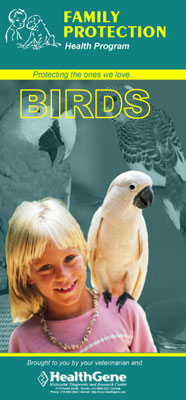Health Program for Birds
FAMILY PROTECTIONHealth Programfor birds contains the most common zoonotic infections:

Chlamydophila psittaci
Cryptosporidium spp.
Mycobacterium spp. (Avian Tuberculosis)
Toxoplasma gondii
HealthGene recommends submitting blood and fecal samples for the
FAMILY PROTRECTION Health Program.
For more information, contact your veterinarian.
CHLAMYDOPHILA PSITTACI
Description:
Chlamydophila psittaci is a bacterium which infects over 100 species of birds including pigeons, raptors and finches. It is commonly found in feral pigeons that appear healthy. When looking at the percentage of the exotic bird population found to be infected, only a small percentage show overt clinical evidence of illness based on physical exam, radiography, and hematologic assessment. Some of the carriers may remain in that state for years with little or no clinical problems, and it is these birds that are contagious to cagemates and people. Transmission occurs through fecal-oral contamination and inhalation of dried discharges and droppings from birds. The infecting organism is present in nasal discharges, droppings, and tissues of infected birds. The droppings are the most common route by which the disease is transmitted to humans. Rehabilitators, veterinarians, and bird banders have a higher infection rate through the birds they andle.
Clinical Signs In Humans:
Clinical signs in people include fever, headache, upper respiratory infection, and pneumonitis.
Clinical Signs In Birds:
Signs in animals include decreades or no appetit, resuling in emaciation. lethargy, respiratory signs, and a greenish blood-tinged diarrhea.
MYCOBACTERIUM SPP (Avian Tuberculosis)
Description:
In birds, tuberculosis is usually caused by Mycobacterium avium and Mycobacterium genovense. It is believed that immunocompetent humans are resistant to the strains of tuberculosis found in birds, but that immunocompromised people \u2013 such a those infected with HIV, those on chemotherapy, the elderly and children \u2013 are at an increased risk. Avian tuberculosis is transmitted by ingestion and inhalation of aerosolized infectious organisms from feces. Incubation in birds is weeks to months. Although many species of birds can be infected, the majority of cases occur in older amazons and grey cheeks. It can survive for a long period of time in the environment and can multiply in inanimate objects.
Clinical Signs In Humans:
In adult humans, tuberculosis frequently affects the lungs, producing respiratory signs. In young children, the cervical lymph nodes are often involved, while immunocompromise people often have the disseminated form.
Clinical Signs In Birds:
Clinical signs for birds range from none in asymptomatic carriers, to mild recurring diarrhea consisting of soft, light-colored stools to acute explosive diarrhea in severe cases. Other signs associated with giardiasis are weight loss, listlessness, mucus in the stool and anorexia.




